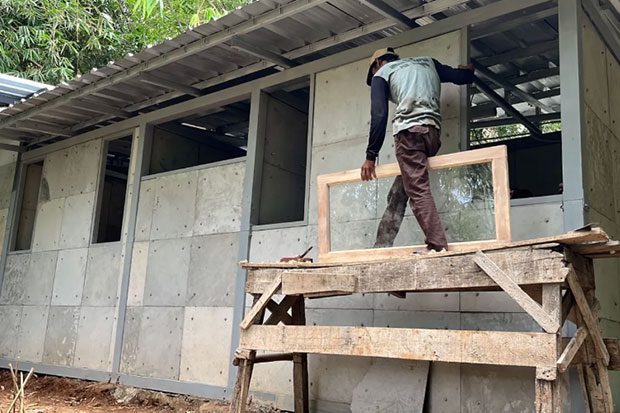Engineers build a small home using disposable diapers in Indonesia
Fortune,

It was an idea born of equal parts inspiration and desperation. Indonesia, facing a steadily rising urban population and high building material costs, was falling farther into a deficit of affordable living space. At the same time, the urban population growth was spurring a massive increase in the use of non-recyclable waste products, including tons of disposable nappies.
Could dirty diapers help solve a developing nation’s housing crisis by replacing some of the materials needed to build new structures?
Perhaps surprisingly, the answer is a qualified yes.
What is happening represents merely the front edge of emerging knowledge, and there are broad caveats about the limitations of what is being attempted. But you don’t need to wonder whether old disposable diapers can be used to help build a new house–and saved from the landfill in the process. It is already happening.
“The material flows associated with concrete production are very large, span the globe, and are very impactful, making them a great focus for innovation like this,” says Michael Lepech, professor of civil and environmental engineering at Stanford University and an expert in sustainable construction. “I haven’t seen this exact work before, and I think it’s exciting to see new innovation in this space.”
As recounted in Scientific Reports, a recent study found that used disposable diapers–cleaned, sterilized, and shredded–could be a substitute for sand in varying ratios in the production of concrete and mortar. The team tested six different sample building materials containing different proportions of diapers to see how much pressure they could withstand, so they’d know how much sand they could replace with diaper shreds and still fall safely within building codes.
The answers were illuminating. For non-load-bearing walls in a house, up to 40% of the sand used for concrete could be replaced by shredded diapers; for columns and beams in a single-story unit, the replacement rate was 27%. For a complete, 387-square-foot home that was constructed, roughly 8% of the sand in concrete and mortar overall could be swapped out for diaper shreds–about 1.7 cubic meters of waste repurposed rather than being dumped straight into a landfill. Those are promising numbers indeed, limited only by the reality that compressive strength decreases as more diaper waste was added.
The approach is not entirely new. “Lots of materials have been used to offset sand or gravel to both dispose of waste and reduce cost,” says engineer John Straube at the University of Waterloo in Canada–but the inclusion of disposable diapers in concrete to build a prototype home is. And there’s a good reason to hope it’s the beginning of a trend: Such diapers are an absolute environmental nightmare.
Disposable diapers are made primarily of plastic and pulp, and they contain significant amounts of superabsorbent polymer fibers, or SAPs. These SAPs, networks of hydrophilic polymer chains, can absorb liquids, turn the liquids into gels, and hold them even when under pressure–exactly what diapers and adult incontinence products are valued for.
The diapers also have a life cycle of at least 500 years, experts say, meaning that the first disposable diapers ever created are most likely still buried in landfills, with centuries to go before they decompose. About 20 billion used diapers worldwide head to landfills each year, where they slowly release harmful chemicals and toxic microplastics into the environment.
The idea of finding any way to repurpose these nappies ought to be applauded. But in a place like Indonesia, where materials can comprise up to 80% of the cost of building a home, figuring out a way to include them in the construction process is particularly appealing.
Siswanti Zuraida, a civil engineer at the University of Kitakyushu and the study’s lead author, noted projections indicating that nearly 70% of all Indonesians will live in urban settings by 2025, according to projections. The nation, however, faces a housing shortage that grows by about 300,000 units each year. Concrete, bricks, wood, and ceramics are primary components of most housing construction, but they may carry real environmental implications, including carbon emissions and eco-costs.
This is, by the way, very much a developing nation story, where high birth rates place acute pressure to produce more housing more quickly. “We in North America don’t use houses made of concrete a lot,” says Waterloo’s Straube, an expert in low-energy sustainable buildings. “High-rise buildings exposed to hurricanes, yes. But the environmental impact of building a house made of concrete is major relative to a wood-frame house, so reducing the impact of concrete on the environment is viable.”
Zuraida and her team followed up on previous research that addresses “the utilization of SAP (in diapers) as concrete components,” she told me. “Those also encourage us to apply their findings on a macro scale, which (was) to build the actual housing by using the diapers as part of building components.”
The team did the dirty work itself, cleaning and sterilizing Zuraida’s own family diapers, then shredding them and letting them cure for 28 days. Although the substitution of diapers for sand could apply to any kind of construction, the 387-square-foot structure was designed with low-cost housing standards in mind, Zuraida says, due to the demand for such housing in Indonesia.
In short, the shredded diapers did what the evidence suggested they could do, effectively replacing a percentage of sand (a natural resource) in various mixtures. The next step, Zuraida says, is to scale the model, but that will take stakeholder buy-in and funding that hasn’t yet appeared.
As for the limitations of the idea, some are obvious. First, shredded diapers can replace only certain fixed percentages of sand, and sand is but one component of concrete. Some environmentally conscious engineers favor plans that avoid concrete, the most widely used substance on earth besides water, to the greatest extent possible.
“Don’t use concrete,” Straube says. “Change diapers to be biodegradable. Using the plastic components as fillers in concrete is better than nothing–but really, only slightly better, with little impact…Plastic is a high impact material that should be either avoided or at the minimum recycled, not ‘down cycled’ to a lower value use.”
Stanford’s Lepech notes that replacing sand with shredded diapers “is about trying to manage the increasing amount of diaper waste being generated. It is not, to a large extent, about improving the sustainability of concrete materials, and it shouldn’t be positioned as such.”
Efforts to innovate the mix in concrete have long been in play. Industrial wastes like fly ash and blast furnace slag have replaced cement in concrete at times. “We also recycle old concrete, crushing it up and mixing the reclaimed gravel back into the concrete, which can work well,” Lepech says. It isn’t clear, he adds, that substituting disposable diapers for sand would save any money–it might even be more expensive to do–and Zuraida’s study notes other limitations, such as the difficulty of collecting the diapers from homes and thoroughly sanitizing them.
Even diaper technology isn’t brand new. More than 100,000 used nappies were recycled to help pave a road in Wales, part of a pilot program designed to reduce the number of diapers that go straight to landfills.
But the Indonesian effort really is attempting to work on two issues at once. The nation’s housing shortage is real–“but building materials are limited,” the Scientific Reports study notes. Finding a way to recycle diapers as part of a concrete mix is one way to create a building material partially out of already existing products.
“Our idea is not yet (ready for) prime time,” says Zuraida. “The research is still in the infant stage.” Just as the infant stage of life around the world produced the massive environmental challenge of disposable diapers, so may this emerging research begin to find more creative ways to meet that challenge–and build a second story on top of it.
This article originally appeared on Fortune.com
This article originally appeared on Fortune.com https://fortune.com/2023/07/13/engineers-build-a-small-home-using-disposable-diapers-in-indonesia/
